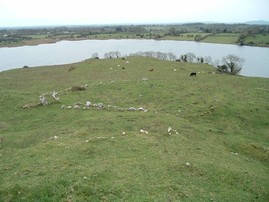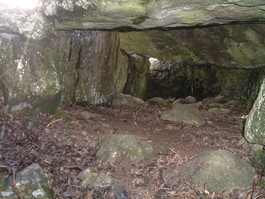Neolithic houses of Knockadoon
 The people who lived here were the first farmers, were small in stature and had a life expectancy of less than 30 years. These structures were circular or rectangular in shape and were made from locally available material – stone, turves and reed and was located on the southern slope of Knockadoon. The site was excavated by Prof. Sean P O’Riordain during the 1950s and revolutionised Irish archaeology at that time. The design of the visitor centre is based on these houses.
The people who lived here were the first farmers, were small in stature and had a life expectancy of less than 30 years. These structures were circular or rectangular in shape and were made from locally available material – stone, turves and reed and was located on the southern slope of Knockadoon. The site was excavated by Prof. Sean P O’Riordain during the 1950s and revolutionised Irish archaeology at that time. The design of the visitor centre is based on these houses.
Megalithic tomb

Locally known as “The Giants Grave” it is a wedge shaped gallery grave and dates to circa 2,500 B.C. and belongs to the final phase of megalithic tomb building which includes passage tombs, portal dolmens and court cairns. It has two chambers – a main chamber and a porticoe. The main chamber is covered with four cap stones. The finds consisted of human bones (both inhumed and cremated), cattle and pig bones, fragments of pottery including food vessels and some flints. A remarkable ox burial was found just outside the main chamber. It has been suggested that it represents a votive offering. It was once used as a home/shelter for an elderly impoverished woman.
